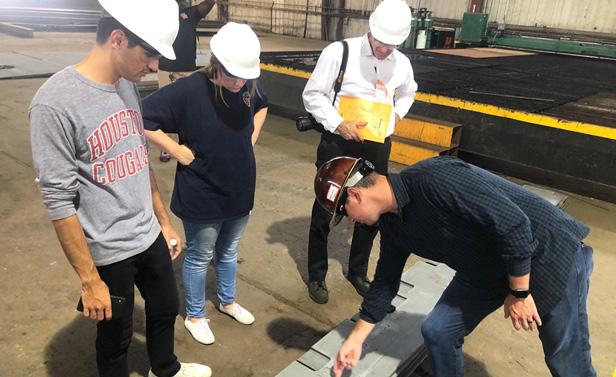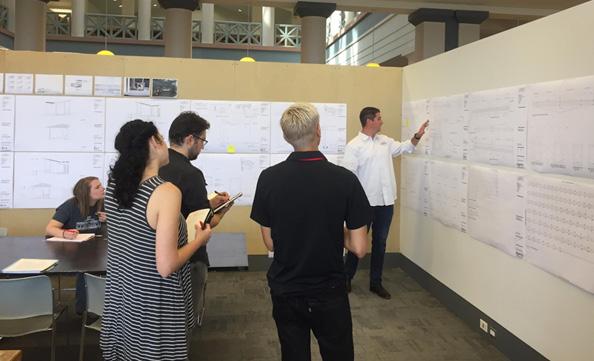
5 minute read
The unexpected mentor
Mentorship is perhaps one of the most powerful ways to lift the next generation of leaders in the built environment. For some, it may mean the difference between having a seat at the table and being left out. Even forgotten. Certainly, some of us do have an air of independence, even bothersome stubbornness. This is especially true in terms of controlling our creative process as designers, but it is likely we have been propped up many times by leaning on folks who bring the valuable expertise we lack. It has been my personal practice to both be a mentor and collect a tribe of mentors in the belief that this surely contributes to the success of our profession and environment.
So, when one of my colleagues reached out to help a group of future architects working to design and donate an outdoor classroom to a middle school, I quickly thought of one individual. Wearing a baby face and appearing to be one mile tall, Joshua Hanson — Josh for short — does not stay in his lane. He is the young and ambitious CEO of MSD Building Corp., a steel fabrication outfit that works on a variety of small- and large-scale projects, including the 21st Century Classroom Building at Texas A&M University, my alma mater.
Hanson’s expertise in steel fabrication was precisely what these young designers would use as intellectual capital. From reducing project costs to eliminating material waste, notions that coincide with the fundamentals of architecture, Hanson became the unexpected mentor
“So this is the process of how steel ends up at your job site,” he explained. “And here we see how this piece is actually made; you can see from the joints.” The sparks that began to fly were not a result of robots cutting and welding, they were sparks of enthusiasm from these future architects, eager to learn more about the role of steel technologies in the design and fabrication process.
Above: Component studies during design development for an outdoor classroom (Image courtesy of Professor Patrick Peters) Above: Josh Hanson, right, shows University of Houston Architecture students the fabrication process of steel members. (Image courtesy of Alex Morales, Assoc. AIA)

As I stood there holding my camera to capture some of these moments, I felt empowered. Empowerment came not because I alone was the curator of the moments captured with my everpresent smartphone appendage, but because I realized I was slowly beginning to answer one of my own questions: Do we do enough?
Architecture has made significant strides in accomplishing a diverse workforce. Not just diversity in race and gender, but diversity in age, perspective, and culture. In front of me stood exactly a representation of a remarkable feat years in the making: a human prism of hues, variation, and knowledge. This small sample of design students from the University of Houston’s College of Architecture & Design, arguably the most diverse institution of higher learning in (also arguably) the most diverse city in the country, represented architecture’s evolving quilt of Asian, Anglo, Black, and Latinx architects in the making. This is the diversity that will certainly strengthen the future of how we design and build. Though the evidence suggests that indeed the AEC professions have made gains in diversity, waltzing in victory is still a bit premature.
In fact, one marker of diversity that must also be equally championed is diversity of thought. Enter the big cloak of mentorship. It is perhaps the best tool for the job, sharpened and refined through literally thousands of hours of individual, separate experiences happening at the same time but of different substance and in different contexts. We call this wisdom. Wisdom is simply wisdom if we keep it bottled up and locked away, selfishly, never to become anything else. Pittance. But when we turn and twist wisdom and share it, it crystallizes into the powerful party that is mentorship.

Above: Josh Hanson, right, participates in a pin-up review during the design development of an outdoor classroom intended for donation to a middle school. (Image courtesy of Patrick Peters)
Patrick Peters, professor of architecture at the University of Houston, is the man orchestrating deliberate interactions across disciplines through his design-build studio. Formally, Peters is an admirable professor churning out the future of architecture, many students at a time. Informally, he has a cupid-esque quality, matching his students with mentors to help them gather support from industries that have a peripheral impact on architecture, like steel fabrication.
Josh the steel fabricator was now Josh the mentor, who happened to be a steel fabricator. Attending pin-up reviews and studio crit was just one page of an effective plan to ensure that his professional knowledge as a fabricator transferred into the design process to find the efficiency, elegance, and robustness that every project deserves. Hanson had used the mentorship playbook again, and suddenly we found ourselves out of class and at Triple-S Steel, a service center that supplies steel located near the belly of Houston’s downtown. Though there were tantalizing whiffs of fall in the background, the high heat and humidity of the day still managed to attack our antsy bodies as we moved through the heartbeat of machinery. Clicking and clunking everywhere, and oddly soothing. Finally, the big reveal was about to happen. The robotic plasma cutter, or RPC, was one precise example of steel technologies that can be leveraged in architecture, a tangential way of eliminating waste and reducing fabrication costs. This is information that generally lives in the domain of a fabricator’s expertise but that can be shared to improve the design process.
After several moments of mentorship, through many months, and through the massaging of the collected information into the design process, the students arrived at the apex, having gone from concept to construction documents. Their project is not only ready to bring purpose as an educational space, in living color and in realness, but the journey to make it happen will continue to echo once these designers enter the workforce. Their example is just one of many that we can take and consider that mentoring, while a generous act of selflessness, is also almost a responsibility. We can do more, and it is empowering.
This article is dedicated to Patrick Peters, professor of architecture at the University of Houston, who continues to inspire, motivate, and fulfill the practical legacies of his students by offering them collaboration through real-world design projects.

Above: Professor Patrick Peters, center, and his students gather in front of Triple-S Steel in Houston for a warehouse tour to understand the steel supply chain. (Image Courtesy of Alex Morales, Assoc. AIA) Alex Morales, Assoc. AIA, EDAC, LEED Green Associate, Morales is a senior structural steel specialist with the American Institute of Steel Construction in Houston. He serves on AIA Houston’s Board of Directors.










